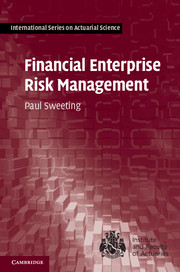Book contents
- Frontmatter
- Contents
- Preface
- 1 An introduction to enterprise risk management
- 2 Types of financial institution
- 3 Stakeholders
- 4 The internal environment
- 5 The external environment
- 6 Process overview
- 7 Definitions of risk
- 8 Risk identification
- 9 Some useful statistics
- 10 Statistical distributions
- 11 Modelling techniques
- 12 Extreme value theory
- 13 Modelling time series
- 14 Quantifying particular risks
- 15 Risk assessment
- 16 Responses to risk
- 17 Continuous considerations
- 18 Economic capital
- 19 Risk frameworks
- 20 Case studies
- References
- Index
5 - The external environment
Published online by Cambridge University Press: 07 October 2011
- Frontmatter
- Contents
- Preface
- 1 An introduction to enterprise risk management
- 2 Types of financial institution
- 3 Stakeholders
- 4 The internal environment
- 5 The external environment
- 6 Process overview
- 7 Definitions of risk
- 8 Risk identification
- 9 Some useful statistics
- 10 Statistical distributions
- 11 Modelling techniques
- 12 Extreme value theory
- 13 Modelling time series
- 14 Quantifying particular risks
- 15 Risk assessment
- 16 Responses to risk
- 17 Continuous considerations
- 18 Economic capital
- 19 Risk frameworks
- 20 Case studies
- References
- Index
Summary
Introduction
The external risk management environment refers to everything that can affect the risks faced by an institution and the way those risks are managed. These factors are not uniform, and vary by industry and geographical location. Even within a particular industry in a particular country, different types of firms might find themselves in different environments. Small firms might be treated differently from large ones, and privately held ones will certainly be treated differently from publicly quoted ones. The list of potential firm-specific factors is extensive – but the important point here is that it is not sufficient simply to look at the industry and location and decide that all firms will be treated the same; rather, it is important every time to consider the nature of the firm and how this affects the external context.
External stakeholders
Since it was established in the previous chapter that the number of internal stakeholders was small, it follows that the number of external stakeholders that might exist is large. All principals except the owner-managers are external to the institutions. This means that the other holders of bank and insurance company debt and equity are external, as are pension scheme sponsors; all customers, policyholders, pensioners and other beneficiaries are external; and clearly the government, the markets and any statutory insurance arrangements are external.
- Type
- Chapter
- Information
- Financial Enterprise Risk Management , pp. 61 - 90Publisher: Cambridge University PressPrint publication year: 2011



